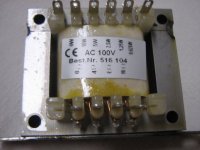It appears your volume pot (R1) case is not grounded. It must be grounded for hum and noise pickup. Run a separate wire from the case or the mounting nut to the ground (0V) bus on your bread board.When I cover the volume pot with my hand, the noise goes a bit down.So, it looks to me, that I have antenas everywhere.
Any ideas?
Cheers,
Pedro
I have used them for a SET hifi amplifier, 3 in parallel for about 3 Watts.
3 watts is nice ... did you use the same resistor values and the 3 anodes connected together to the transformer?
Hi,It's oscillating.
Put a 22-47 ohm into the anode lead and/or a small choke.
.
The addition of the resistor, didn't stop the oscillations. However, when I added a 180uF/450V cap to the supply (where the transformer connects) it stopped oscillating.
Besides the hiss, there was a bassy sound, like a drum playing without stopping.
All of this is, now, resolved.
Naive questions:
1-is polarity of the transistor important AC wise? That is, will it make a difference if I connect the common's (Centre Tap) primary side to the anode or to the power rail?
2-should the transformer be connected between a given tap and the common or between that tap and the highest/lowest on the primary?
In my case I have the following TAPs:
10W, 5W, 2.5W, 1.25W, 0.625W and common. I am connecting between 0.625W and common. Will I get the most power with this configuration?
Thanks,
Pedro
The only output transformers I know which have primary taps labeled in Watts like yours are those little 100V line matching transformers.
They are not meant to be used single ended with DC current through the primaries but I found they work quite well with standing currents up to 20mA. Their laminations are assembled E-I style which inevitably produces a small air gap, albeit not specified and somewhat undefined.
If you have 4 ohm speakers and hooked them up between the 0 and 4 ohm tap on the secondary, you are using the full primary winding if you connect the power line to the 0.65W tap and the plate to the 0. Or vice versa, doesn't really matter.
That way the 4 ohm speaker impedance is reflected as 15 kohms to the primary, and this is what loads the tube.
Had you used the 1.25W tap, the reflected load would have been 7.5 kohm.
Use the 2.5W tap and you get 3.25 kohm a.s.o.
Now which one to pick is up to you.
Probably the 15k loading is a practical choice for audio reproduction, good compromise between distortion and power with that configuration.
7.5k gets you a little more power but also more distortion.
More so with 3.25k ... if its an instrument amp, give it a try.
If its for audio, I would stay with 15K or even try and hook up 4 ohm speakers to the 8 ohm tap which gives 30k load (or 8 ohm speakers to the 16 ohm tap which is the same).
They are not meant to be used single ended with DC current through the primaries but I found they work quite well with standing currents up to 20mA. Their laminations are assembled E-I style which inevitably produces a small air gap, albeit not specified and somewhat undefined.
If you have 4 ohm speakers and hooked them up between the 0 and 4 ohm tap on the secondary, you are using the full primary winding if you connect the power line to the 0.65W tap and the plate to the 0. Or vice versa, doesn't really matter.
That way the 4 ohm speaker impedance is reflected as 15 kohms to the primary, and this is what loads the tube.
Had you used the 1.25W tap, the reflected load would have been 7.5 kohm.
Use the 2.5W tap and you get 3.25 kohm a.s.o.
Now which one to pick is up to you.
Probably the 15k loading is a practical choice for audio reproduction, good compromise between distortion and power with that configuration.
7.5k gets you a little more power but also more distortion.
More so with 3.25k ... if its an instrument amp, give it a try.
If its for audio, I would stay with 15K or even try and hook up 4 ohm speakers to the 8 ohm tap which gives 30k load (or 8 ohm speakers to the 16 ohm tap which is the same).
Attachments
Last edited:
Hi,
Thanks for the detailed explanation.
You are right, I am using a 100V line transformer with a 4Ω speaker.
I've chosen a line transformer due to its low price. Next time I will go with a Hammond output transformer.
This is for guitar, so the extra distortion is ok for me.
Cheers,
Pedro
Thanks for the detailed explanation.
You are right, I am using a 100V line transformer with a 4Ω speaker.
I've chosen a line transformer due to its low price. Next time I will go with a Hammond output transformer.
This is for guitar, so the extra distortion is ok for me.
Cheers,
Pedro
As in a line transformer the reflected impedance calculates to Z = U²/P, the 0.625 W terminal in your example corresponds to 16 kohms. The 2.5 W tap is the center, so this line transformer fits well as an OT for a guitar amplifier with the plates connected to common and 0.625 W, and Ub to 2.5 W.
Best regards!
Best regards!
- Home
- Amplifiers
- Tubes / Valves
- Subminiature tubes Spice models
